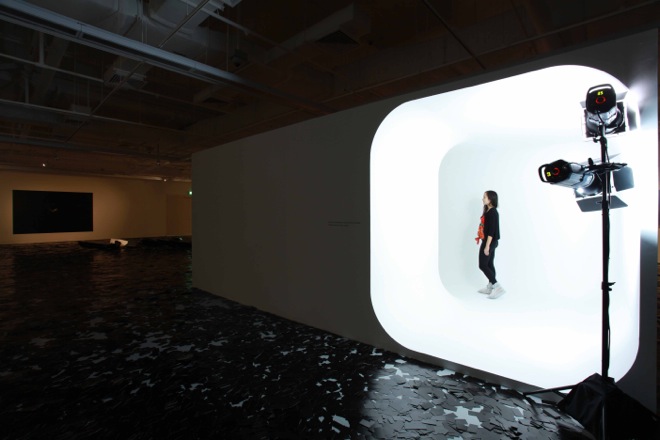“Countershadows (tactics in evasion)” – group exhibition with Heman Chong, Tamares Goh, Ho Rui An, Sai Hua Kuan, Jeremy Sharma, Tan Peiling and Robert Zhao Renhui.
Institute of Contemporary Arts Singapore (1, McNally Street, Singapore) Sep 20–Oct 26, 2014
How do you discuss something which is concealed, if doing so is to draw attention to—and thus negate—that concealment? Would an inquiry into evasion be itself evasive? These questions seem to flow through the Institute of Contemporary Arts Singapore’s latest show, “Countershadows (tactics in evasion)”, charting a path from the birth of modern camouflage to some slippery usages in contemporary art.
This conceptual slipperiness finds literal expression in Heman Chong’s “Monument to the people we’ve conveniently forgotten (I hate you)” (2008– ), which consists of a million plain black business cards scattered across the gallery’s expanse in slippery, slightly reflective drifts. If you have ever moaned about having a million cards you’ve yet to look at, the work ought to dispel some of that hyperbole. It might be a nod to the endless rounds of tedious networking that takes place in the art world, but it proffers more than just a cynical observation; while literally comprising discards to be trodden upon, it also envelops the space, somehow remaking the gallery’s interior as some strange and blasted landscape—shades of allegorical deserts—with random drifts of cards drawing attention to your own (now squeaky, slippery) footfalls.
Dominating this terrain like the monoliths in 2001: A Space Odyssey is Sai Hua Kuan’s “Something Nothing” (2007)—a white cuboid resting atop the blackened landscape, with a well-lit squircularaperture as its most prominent feature. Entering the structure (which requires the ritual purification of doffing one’s shoes and donning translucent plastic foot-covers) offers a rare perceptual treat—the lights by the entrance, combined with the interior’s geometry, cancel out all the shadows within, in what might be a literal application of the show’s title.
Left without visual and spatial cues (as one might find in a whiteout) there’s a sense of being cast adrift in a limitless void: a curious blend of claustrophobia and agoraphobia, seasoned with a nagging discomfort at how easily our senses can be short-circuited. It is somehow reminiscent of The Hitchhiker’s Guide to the Galaxy‘s “Total Perspective Vortex”, except instead of a scale reference of yourself relative to the universe, you’re confronted by a yawning expanse of coolly indifferent attempts at meaning and signification. Belying the work’s sci-fi appearance, it is composed of workaday, fallible (the structure’s surface is a little prone to creaking and cracking) materials like house paint and plywood. Along with the exposed lighting setup, the work remains within some comprehensible domain, as if it were a magician’s trick that reveals its workings while not sacrificing its illusion.
Process and material are also foregrounded in a series of evocatively titled (“Unicorn” (2014), “Liner” (2014), and “Red Herring” (2014)) sculptural works by Jeremy Sharma that rest on the gallery’s floor. Like “Something Nothing”, these sculptures seem quite at home rising out of Heman Chong’s landscape of black cards—but as gravid totems rather than a serenely impassive monolith. The works’ serial forms seem factory-fresh from some unknown production line, molds for undisclosed automotive and other industrial parts.
Both familiar and alien, these ghosts of our manufactured world, recalling J.G. Ballard, could offer some mute testament to accidental poetry and other hidden depths—the stylized forms in “Unicorn”, for one, manage to simultaneously suggest pharaonic tombs and commonplace automobiles. In receding behind these automated, computer-aided processes, Sharma appears to eschew traditional modes of craft, at once placing long-standing artistic processes within the same frame as computer-mediated production, paradoxically drawing attention to artistic conventions by receding away from them.
Further varieties of ambiguity and equivocation find expression throughout the show. For instance, Robert Zhao Renhui’s evolutionary bio-fiction “White House Crow” (2013) translates the story of the Peppered Moth’s adaptation to developments in British industry to Singapore’s own brand of reclamation-mad development, just as the work’s principal image, an adhesive vinyl print applied directly to the gallery wall, is slated to be destroyed along with the take-down of the show.
For the show as a whole, though, ambiguity and equivocation seem to have been translated into a stark monochromaticism—of white and black and all the shades of grey in between, the greys in particular being meditatively discussed in Ho Rui An’s “A Difficulty (Grey)” (2014). Despite the odd splash of warm gallery spotlights, the emphasis placed on immediate, immaculate visual impact hints at the possibility of some misdirection, a flawless veneer that leaves one wondering about what might have been papered over – if perfect visual coherence was achieved at the cost of some unseen instability. Even as color’s decorative character can be made to conceal something more essential, what if the show’s equivocal tendencies apply here also? That the monochrome, rather than an absence of distracting decoration, could itself be a subtler form of camouflage, its coolness but a masquerade of essence?




